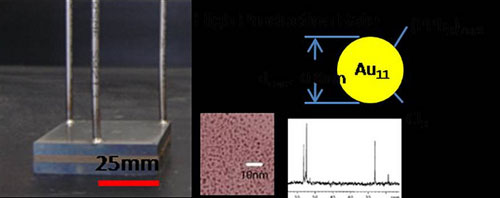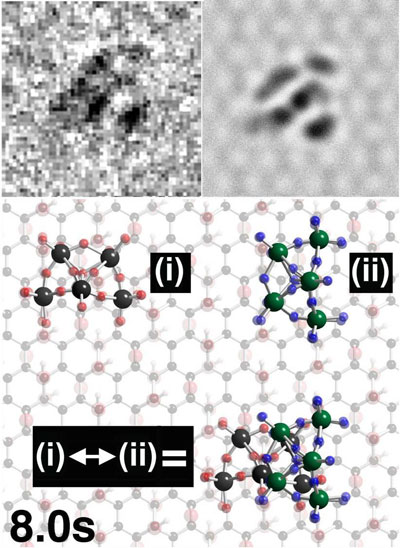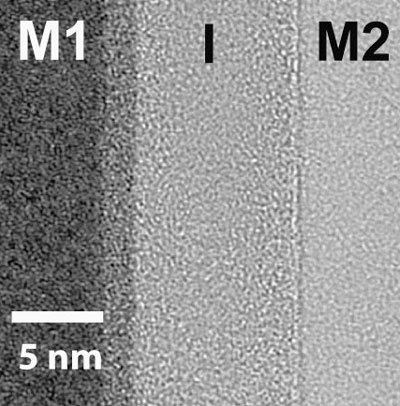 Engineers at Oregon State University have discovered a new method to speed the production rate of nanoparticles by 500 times, an advance that could play an important role in making nanotechnology products more commercially practical.
Engineers at Oregon State University have discovered a new method to speed the production rate of nanoparticles by 500 times, an advance that could play an important role in making nanotechnology products more commercially practical.
Nov 1st, 2010
Read more
Braided anyons could lead to more robust quantum computing.
Nov 1st, 2010
Read more
 The single layer material Graphene was the subject of a Nobel prize this year but research led by a team of researchers at the University of Warwick has found molecular hooks on the surface of its close chemical cousin, Graphene Oxide, that will potentially provide massive benefits to researchers using transmission electron microscopes. They could even be used in building molecular scale mechanisms.
The single layer material Graphene was the subject of a Nobel prize this year but research led by a team of researchers at the University of Warwick has found molecular hooks on the surface of its close chemical cousin, Graphene Oxide, that will potentially provide massive benefits to researchers using transmission electron microscopes. They could even be used in building molecular scale mechanisms.
Nov 1st, 2010
Read more
The 1-year-old Institute for Intelligent Energy Systems at UT Dallas has received its first major research grant: a one-year, $1.25 million award from the U.S. Department of Energy to explore the use of nanotechnology in electrical energy storage.
Nov 1st, 2010
Read more
The EU's SMARTHIEHS project will make the testing of MEMS structures one hundred times as fast as it is now, leading to cheaper and more reliable electronic equipment for everyone.
Nov 1st, 2010
Read more
Singapore's Agency for Science, Technology and Research (A*STAR) today announced the funding of eight new projects under its Capabilities for Automotive Research (A*CAR) consortium, bringing the total value to S$17.5 million for the consortium's 10 research projects jointly selected with industry partners to tackle current challenges in the automotive industry.
Nov 1st, 2010
Read more
The Nanotechnology Coalition, affiliated with the Society of Chemical Manufacturers and Affiliates (SOCMA), is pleased to announce its support for the NanoSafety Consortium for Carbon (NCC) and the SOCMA Nanotechnology Coalition's new designation as a supporting institute/association under NCC's by-laws.
Nov 1st, 2010
Read more
The Air Force Office of Scientific Research today announced it will award approximately $16.5 million in grants to 43 scientists and engineers who submitted winning research proposals through the Air Force's Young Investigator Research Program.
Oct 30th, 2010
Read more
Recognizing the innovative ideas of today's college and university students, the Collegiate Inventors Competition, a program of Invent Now, announced that a way to implant human liver cells in mice to facilitate drug testing and a way to manufacture composite structural poles have won top honors in this year's competition.
Oct 30th, 2010
Read more
A team of professors at Arizona State University, including three faculty members of the Sandra Day O'Connor College of Law, has received a quarter-million-dollar federal grant to pursue their research of nanotechnology regulation.
Oct 30th, 2010
Read more
A team from The Scripps Research Institute has revealed the first-ever pictures of the formation of cells' 'protein factories'. In addition to being a major technical feat on its own, the work could open new pathways for development of antibiotics and treatments for diseases tied to errors in ribosome formation.
Oct 29th, 2010
Read more
 Researchers at Oregon State University have solved a quest in fundamental material science that has eluded scientists since the 1960s, and could form the basis of a new approach to electronics. The discovery outlines the creation for the first time of a high-performance 'metal-insulator-metal' diode.
Researchers at Oregon State University have solved a quest in fundamental material science that has eluded scientists since the 1960s, and could form the basis of a new approach to electronics. The discovery outlines the creation for the first time of a high-performance 'metal-insulator-metal' diode.
Oct 29th, 2010
Read more
The University of Houston has received a $1.2 million grant from the Office of Naval Research to help design the next generation of technologies for the alternative energy industry.
Oct 29th, 2010
Read more
The PhD thesis by Carlos Echeverria Arrondo, Doctor in Physics from the Public University of Navarre and entitled 'On doped semiconductor quantum dots and magnetic nanowires', studies the behaviour and properties of nanometric-scale semiconductor crystals.
Oct 29th, 2010
Read more
Physiker der TU Graz publizierten ihre neuesten Ergebnisse auf dem Gebiet der Halbleitertechnologie: Sie beantworteten auf Basis einer quantenmechanischen Simulation grundlegende Fragen zur Aenderung von Grenzflaecheneigenschaften von Elektrodenmaterialien mit organischen Molekuelen.
Oct 29th, 2010
Read more
PhDGermany - the platform for doctoral positions and research opportunities in Germany is the latest service offered by the DAAD and is aimed at attracting international doctoral candidates.
Oct 29th, 2010
Read more
 Engineers at Oregon State University have discovered a new method to speed the production rate of nanoparticles by 500 times, an advance that could play an important role in making nanotechnology products more commercially practical.
Engineers at Oregon State University have discovered a new method to speed the production rate of nanoparticles by 500 times, an advance that could play an important role in making nanotechnology products more commercially practical. 


 Subscribe to our Nanotechnology News feed
Subscribe to our Nanotechnology News feed